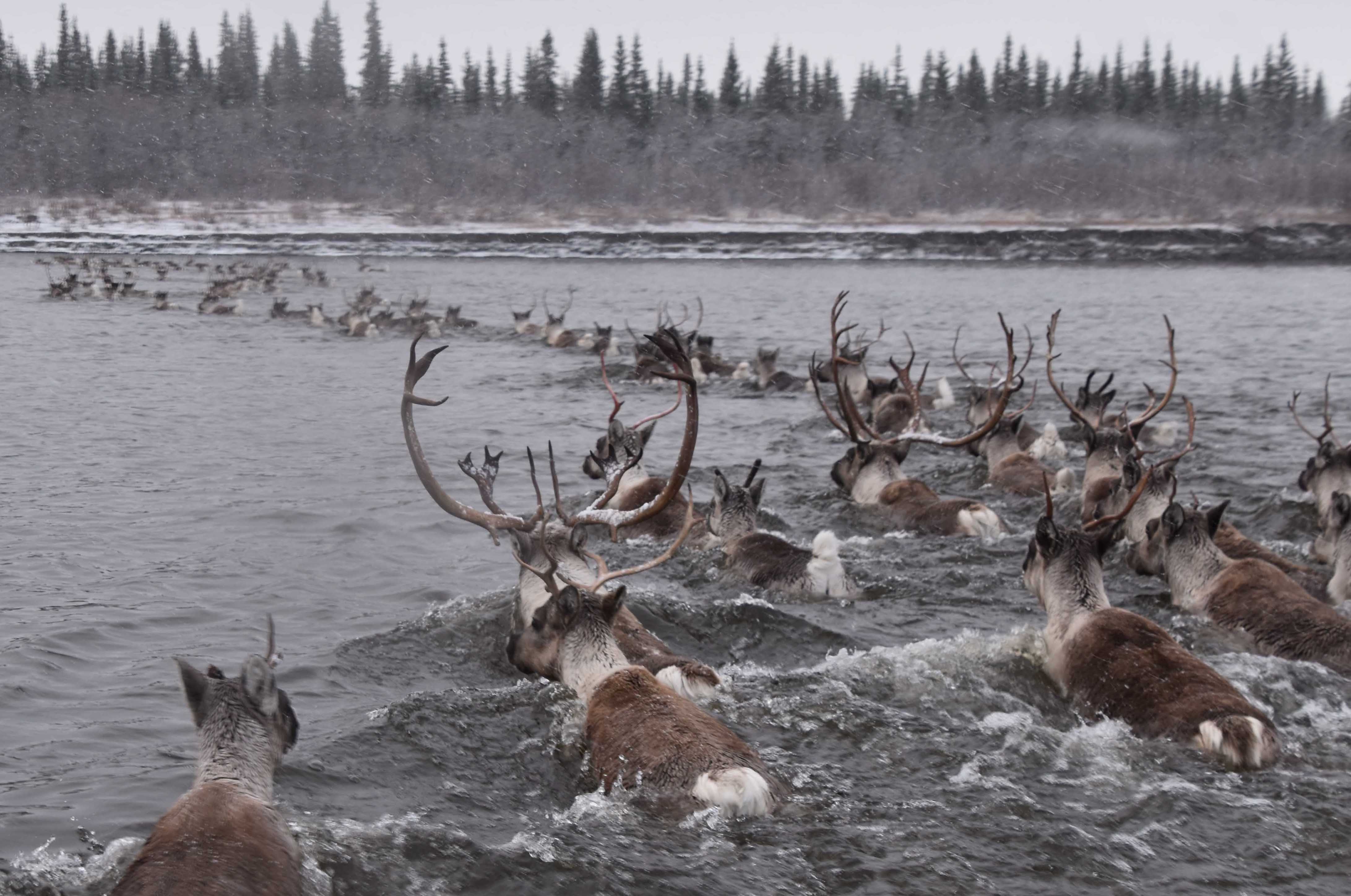Investigating Climate Change’s Impact on Arctic Caribou
UMD graduate students Marron McConnell and Qianru Liao are combining their expertise in biomathematics and remote sensing to learn how climate change shapes caribou population dynamics and migration behavior in the Arctic.
For millennia, caribou have played an essential role in both ecological and human systems in the Arctic. As migrating herbivores, caribou consume vegetation and redistribute nutrients along thousands of miles during their journey to and from their winter grounds and summer calving grounds. In addition, indigenous peoples have historically depended on caribou for food, clothing, shelter and their overall livelihoods—an enduring cultural relationship that continues today.

Yet today, fewer caribou roam freely across the Arctic Circle; since the mid-1990s, the size of caribou herds has decreased by 56%, from an estimated 4.7 million caribou to about 2.1 million. For Arctic ecologists and conservationists, this sharp decline is a stark reminder that the Arctic’s warming temperatures in recent years dramatically reshaped living conditions in the region.
University of Maryland graduate students Marron McConnell and Qianru Liao are digging deeper into just how climate change is altering caribou population dynamics and influencing their behavior during the most crucial parts of the animals’ lives.
“Since 2000, average temperatures in the Arctic have risen about twice as fast as global temperatures,” said McConnell, a Ph.D. candidate in the Behavior, Ecology, Evolution and Systematics (BEES) concentration of the biological sciences graduate program at UMD. “For decades, people wondered whether declines of certain caribou herds were caused by parasites, disease, hunting or the loss of habitat from human development or wildfire. Many of those are exacerbated by climate change. Even though we know that it’s the core issue, it’s hard to pinpoint just one specific cause and effect because of how interconnected all the challenges are.”

McConnell and Liao’s goal is to fill in these gaps of knowledge to gain additional insight into what humans can do to support caribou populations. Using decades of remote satellite imaging and data gathered from hundreds of tag-monitored caribou, McConnell is developing mathematical models simulating caribou population demographics and fluctuation while Liao analyzes the relationship between caribou decision-making during migrations and environmental conditions.
These projects are the latest in a series of migration-related research projects being conducted in the lab of their advisor Distinguished University Professor of Biology Bill Fagan.
“Spatial ecology and movement ecology are so challenging because they sit at an interface between complex biological processes and environmental heterogeneity," Fagan said. "Organism-level data, remotely sensed data, statistical analyses and mathematical models are all essential to understanding such thorny problems.”
Fagan, McConnell and Liao are also part of Fate of the Caribou, a multi-institutional collaborative research group funded by the U.S. National Science Foundation to better understand the complex relationship between caribou, their ecosystems and the human communities around them. Together, they’re helping to build a broader perspective on the impact of climate change in the remote reaches of the Arctic.
“Climate change has many primary effects on caribou environments, like the early melting of ice,” said Liao, who is a Ph.D. student in the Marine, Estuarine, and Environmental Sciences graduate program (MEES). “But there are other impacts that haven’t been as well-researched. How will a migrating caribou react to the ice melt of lakes and rivers? Will that change their route to their destination? That’s why we’re working to break it all down, get a bigger picture understanding of the problems and help stakeholders come up with more targeted solutions to save caribou, a keystone species in the Arctic ecosystem.”
How geography influences caribou psychology
A trained geographer, Liao studies how living populations interact with nature. Her work encompasses that connection between geography and biology, which she hopes will lead to breakthroughs in understanding how migrating caribou successfully navigate the Arctic tundra.
“I match the moving GPS locations I get from caribou tracking collars to albedo data—or how sunlight reflects from the Earth’s surface—obtained from satellites,” she explained. “The more reflective an area, the more ice and snow is in that location. Land surface reflectance is another indicator that lets me know the degree to which ice is melting or freezing, which helps me figure out if there’s a special pattern in the timing of ice breakage or formation along the caribou’s journey.”

With climate change causing earlier thaws in spring migration, caribou are increasingly forced to navigate hazardous ice conditions by choosing more complicated land routes. Walking on fragile, thin ice and swimming pose significant risks of death for migrating caribou. It’s also more difficult for the animals to take the same paths consistently, leading to possible unwanted incursions with humans.
“Ice conditions impact water-crossing behavior and that in turn affects caribou energy levels and their ability to birth safely and successfully,” Liao said. “I’m learning about what motivates them to circumvent versus cross lakes and rivers via ice, how much time and space is taken to do those actions and if they can remember these experiences as newer generations of caribou build migration routes. Reconstructing that migratory landscape and understanding what’s motivating caribou to take these paths can help protect them in the long run.”
Making a math model for the future
McConnell is also mapping out caribou responses to climate change, but through population demographics analyses and modeling. Her goal is to create an accurate model simulating caribou population fluctuation based on known birth, death, immigration and emigration data.
“I utilize information from different caribou herds through tracking collars and aerial photographic surveys,” McConnell said. “Those are both rich sources of information because they accurately log when something happened to the caribou and also what happened. When a collar suddenly starts indicating the animal has stopped moving entirely, it likely means that the caribou has died and from that we can start to understand survival metrics. GPS data can also connect to seasonal changes like temporary road barriers erected by humans for diamond mining activities in that area, for example.”
McConnell says that this work also allows her to see “what hits caribou the hardest,” as well as when and where they are at risk.
“There are many factors in caribou population decline, but increased temperatures from climate change can impact so many variables,” she explained. “Shifts in food availability—especially wildfires that can wipe out vegetation and freezing rain creating ice sheets that block access to vegetation—can make it difficult for traveling caribou to build ideal body condition for breeding. Warmer temperatures also bring more bug harassment, which wastes their energy and causes them to ruminate poorly.”
These historical patterns can help form a broader perspective of caribou population changes, including important details such as age, location and cause of death. McConnell’s models will enable researchers to test out different mechanisms of decline without needing new live data from real caribou and to predict how climate and other factors might impact populations in the future.
Caring for caribou and the human communities around them

McConnell and Liao were both drawn to the Fagan Lab’s work on caribou because of the collaborative nature of the projects. Both researchers believe that every member’s contribution is crucial to piecing together a more accurate picture of conditions for caribou in the Arctic and how climate change may affect those conditions.
For McConnell and Liao, the long-term goal is to bring their research to the public, particularly to the indigenous populations who depend on caribou. The Fate of the Caribou group is already working to make their data and findings accessible to residents living or working in the region between Northern Canada and Alaska, collaborating with federal agencies, indigenous governments and “boots on the ground” programs in the area. Using the information collected and summarized by the team, human communities most directly impacted by caribou can be empowered to make informed decisions about the natural environment around them and their way of life.
“There is no isolating a problem in ecology because of how interconnected everything is, even stuff you can’t possibly imagine is connected,” McConnell said. “We have to be mindful that every decision we make can impact everything else.”
Liao added: “We want to ensure the survival of a species while also working to reinforce networks of communication between all of us because addressing climate change and its impacts is a massive group effort, no matter where in the world we live.”
###
The Fate of the Caribou Project is supported by the U.S. National Science Foundation (Grant No. 2127271) and hosted by the State University of New York College of Environmental Science and Forestry, where former UMD Department of Biology postdoctoral associate Eliezer Gurarie is now a faculty member.







